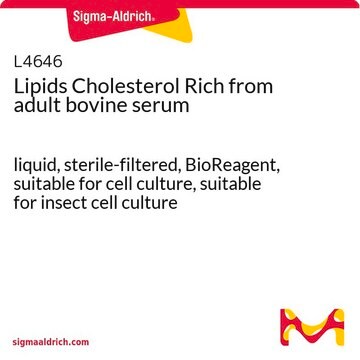L0288
Lipid Mixture 1, Chemically Defined
liquid, sterile-filtered, BioReagent, suitable for cell culture
Synonym(s):
ACF lipid mixture
About This Item
Recommended Products
biological source
non-animal source
sterility
sterile-filtered
product line
BioReagent
form
liquid
technique(s)
cell culture | mammalian: suitable
impurities
≤10 EU/mL endotoxin
storage temp.
2-8°C
Related Categories
General description
Application
- as a component of bovine serum albumin (BSA) containing Bracket-Oliphant (BO) medium for the resuspension of sperm pellet
- as a supplement in spheroid media for culturing primary human subcutaneous stromal vascular fraction cells
- to prepare a cell steatosis model for culturing of mouse and human hepatocytes
Other Notes
related product
Storage Class Code
10 - Combustible liquids
WGK
WGK 1
Flash Point(F)
Not applicable
Flash Point(C)
Not applicable
Certificates of Analysis (COA)
Search for Certificates of Analysis (COA) by entering the products Lot/Batch Number. Lot and Batch Numbers can be found on a product’s label following the words ‘Lot’ or ‘Batch’.
Already Own This Product?
Find documentation for the products that you have recently purchased in the Document Library.
Customers Also Viewed
Articles
Importance and uses of linolenic acid in serum-free eukaryotic, including hybridoma and Chinese Hamster Ovary (CHO) cell, cultures
How palmitic acid, other fatty acids and other cell culture components affect the performance of serum-free, protein-free cell culture systems used for biomanufacturing heterologous proteins including monoclonal antibodies.
Importance and uses of linoleic acid in serum-free eukaryotic, including hybridoma and Chinese Hamster Ovary (CHO) cell, cultures
How the unsaturated fatty acid, oleic acid and other cell culture components affect the performance of serum-free, protein-free cell culture systems used for biomanufacturing heterologous proteins including monoclonal antibodies.
Our team of scientists has experience in all areas of research including Life Science, Material Science, Chemical Synthesis, Chromatography, Analytical and many others.
Contact Technical Service









